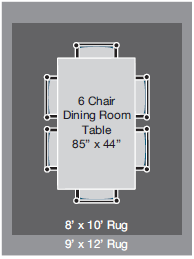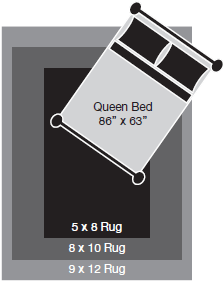Your Cart is Empty
WHAT'S THE RIGHT-SIZED RUG FOR MY ROOM?
Determining the proper size for a rug is just as important as finding the right color and pattern. The size and shape of your rug can help determine and define furniture groupings as well as areas of use, such as conversation areas. Multiple rugs can link one room to another. Furniture can be centered on the rugs or positioned off the rug depending on the size of the room and the feeling you are after. Companion rugs can be of different patterns, but should share a similar color palette.
MEDIUM SIZED ROOMS

For medium sized rooms, area rugs are typically 5' x 8'. This size is great for smaller bedrooms, home offices, and in living rooms under the coffee table.
Under the Coffee Table
- Depending upon the size of your coffee table and accompanying furniture, choose a rug that accommodates all 4 legs of the table.
- Area rugs should approximate the same length and width of the furniture within the space.
- You can either leave some space between the furniture and area rug or place the front legs of the furniture on the rug with furniture coasters under the back legs adjusting for height.
LARGE SIZED ROOMS

Large rooms typically require an 8' x 10 or larger area rug. This size of rug is great for living rooms, great rooms, dining rooms, and master bedrooms. Instead of arranging the furniture and rug in a traditional alignment, a new twist might be to angle the rug underneath; or angle the bed/sofa/dining table and rug to match.
Dining Rooms
- An 8' wide rug can accommodate most dining tables, but add at least 4' to the length and width of your table measurements to be sure.
- Rugs should extend beyond the chairs in the pulled out position.
Living Rooms / Great Rooms
- Balance the area you are trying to define by leaving an equal amount of rug around the furniture grouping.
- An equal amount of exposed flooring around your rug can also give balance to your room.
Bedrooms

- In bedrooms, one large rug is luxurious, but the bed will cover most of it. Smaller equal-sized rugs used around the bed are another option. The soft comfort of a rug is most appreciated when stepping in and out of bed.




